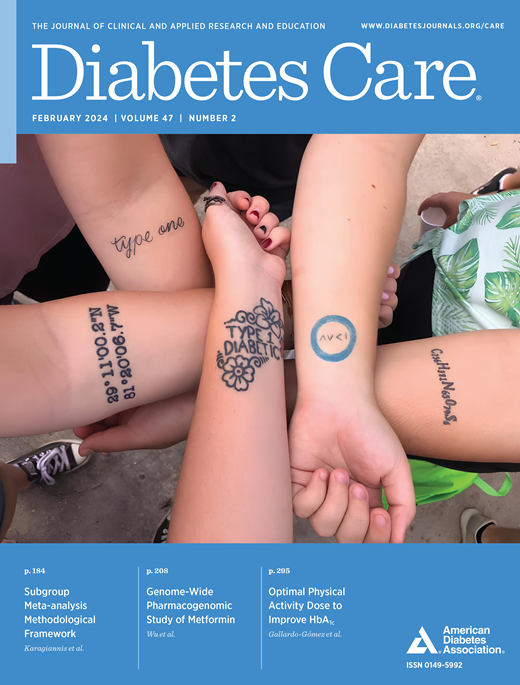Choline Metabolites and 15-Year Risk of Incident Diabetes in a Prospective Cohort of Adults: Coronary Artery Risk Development in Young Adults (CARDIA) Study
IF 16.6
1区 医学
Q1 ENDOCRINOLOGY & METABOLISM
引用次数: 0
Abstract
OBJECTIVE The potential for choline metabolism to influence the development of diabetes has received increased attention. Previous studies on circulating choline metabolites and incident diabetes have been conducted in samples of older adults, often with a high prevalence of risk factors. RESEARCH DESIGN AND METHODS Participants were from year 15 of follow-up (2000-2001) in the Coronary Artery Risk Development in Young Adults (CARDIA) Study (n = 3,133, aged 33–45 years) with plasma choline metabolite (choline, betaine, and trimethylamine N-oxide [TMAO]) data. We quantified associations between choline metabolites and 15-year risk of incident diabetes (n = 387) among participants free of diabetes at baseline using Cox proportional hazards regression models adjusted for sociodemographics, health behaviors, and clinical variables. RESULTS Betaine was inversely associated with 15-year risk of incident diabetes (hazard ratio 0.76 [95% CI 0.67, 0.88] per 1-SD unit betaine), and TMAO was positively associated with 15-year risk of incident diabetes (1.11 [1.01, 1.22] per 1-SD unit). Choline was not significantly associated with 15-year risk of incident diabetes (1.05 [0.94, 1.16] per 1-SD). CONCLUSIONS Our findings are consistent with other published literature supporting a role for choline metabolism in diabetes. Our study extends the current literature by analyzing a racially diverse population-based cohort of early middle-aged individuals in whom preventive activities may be most relevant.前瞻性成人队列中的胆碱代谢物与 15 年糖尿病发病风险:年轻人冠状动脉风险发展(CARDIA)研究
目的 胆碱代谢对糖尿病发病的潜在影响日益受到关注。以往有关循环胆碱代谢物和糖尿病发病率的研究都是在老年人样本中进行的,这些老年人通常具有较高的风险因素。研究设计和方法 参与研究的人员来自青年冠状动脉风险发展(CARDIA)研究随访的第 15 年(2000-2001 年)(n = 3,133 人,年龄 33-45 岁),他们都有血浆胆碱代谢物(胆碱、甜菜碱和三甲胺 N-氧化物 [TMAO])数据。我们利用经社会人口统计学、健康行为和临床变量调整的 Cox 比例危险回归模型,量化了基线无糖尿病的参与者中胆碱代谢物与 15 年糖尿病发病风险(n = 387)之间的关系。结果 甜菜碱与15年糖尿病发病风险成反比(每1-SD单位甜菜碱的危险比为0.76 [95% CI 0.67, 0.88]),TMAO与15年糖尿病发病风险成正比(每1-SD单位TMAO的危险比为1.11 [1.01, 1.22])。胆碱与 15 年糖尿病发病风险无明显相关性(1.05 [0.94, 1.16]/1-SD)。结论 我们的研究结果与其他已发表的支持胆碱代谢在糖尿病中作用的文献一致。我们的研究通过分析基于不同种族人群的中年早期组群,扩展了现有的文献。
本文章由计算机程序翻译,如有差异,请以英文原文为准。
求助全文
约1分钟内获得全文
求助全文
来源期刊

Diabetes Care
医学-内分泌学与代谢
CiteScore
27.80
自引率
4.90%
发文量
449
审稿时长
1 months
期刊介绍:
The journal's overarching mission can be captured by the simple word "Care," reflecting its commitment to enhancing patient well-being. Diabetes Care aims to support better patient care by addressing the comprehensive needs of healthcare professionals dedicated to managing diabetes.
Diabetes Care serves as a valuable resource for healthcare practitioners, aiming to advance knowledge, foster research, and improve diabetes management. The journal publishes original research across various categories, including Clinical Care, Education, Nutrition, Psychosocial Research, Epidemiology, Health Services Research, Emerging Treatments and Technologies, Pathophysiology, Complications, and Cardiovascular and Metabolic Risk. Additionally, Diabetes Care features ADA statements, consensus reports, review articles, letters to the editor, and health/medical news, appealing to a diverse audience of physicians, researchers, psychologists, educators, and other healthcare professionals.
 求助内容:
求助内容: 应助结果提醒方式:
应助结果提醒方式:


